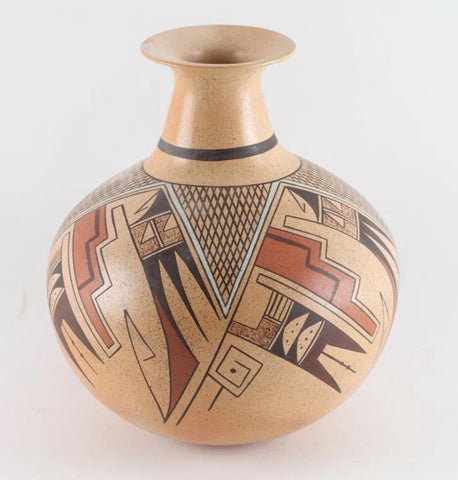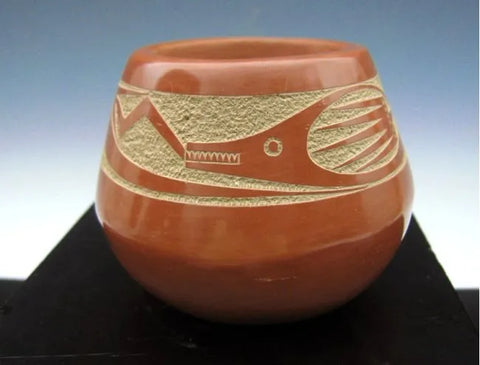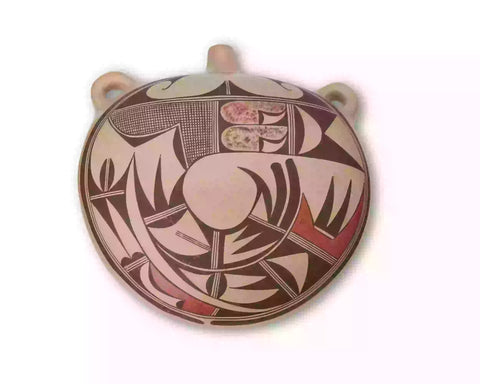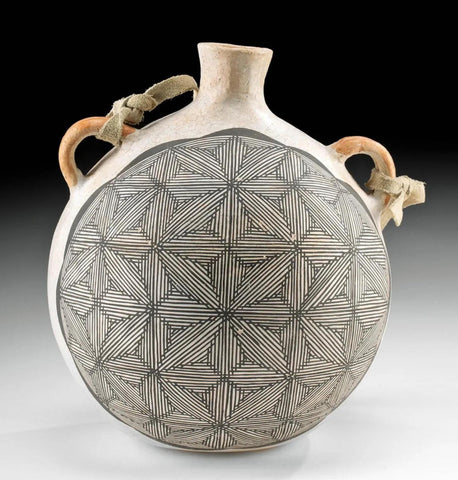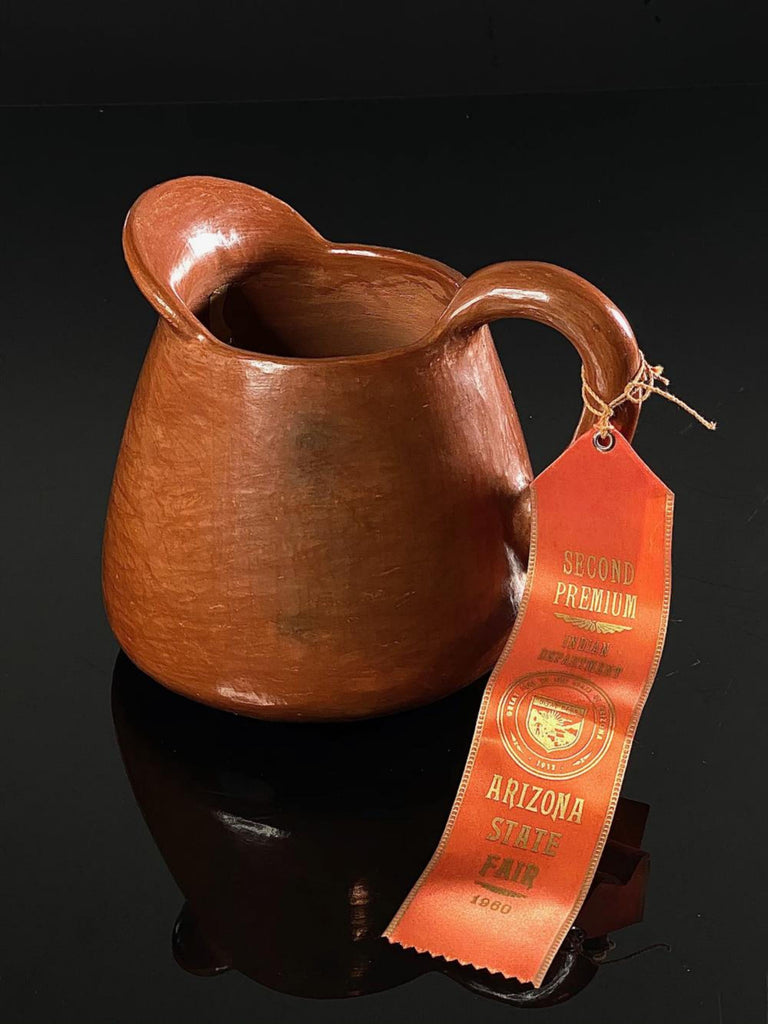
Native American San Ildefonso Pottery Pitcher, Attributed to Rose Gonzales, Ca 1960, #1581 SOLD
$ 2,500.00
Native American San Ildefonso Polished Red Pottery Pitcher, Attributed to Rose Gonzales (1900-1989), Ca 1960, #1581
Description: Native American San Ildefonso Pottery Pitcher, Attributed to Rose Gonzales, (1900-1989), Ca 1960, #1581. Awarded the Second Premium award from the Indian Department at the Arizona State Fair, 1960. The Ribbon is attached to the piece.
Dimensions: 6.25in H x 6.5in W x 7in D
Condition: Excellent for its age.
Biography and artistic career
Rose Gonzales (1900 to 1989) was born in San Juan Pueblo in the U.S. state of New Mexico around the beginning of the 20th century. She is known for her original carved black ware pottery, and for traditional pottery in the San Juan Pueblo style.
When she was very young, her parents died during a swine flu epidemic. She and her sister Pomasen were left orphans and lived with a relative, Mary Cata. In 1920 Gonzales married Robert Gonzales and, along with her sister, moved to his native pueblo of San Ildefonso.
It was her mother-in-law, Ramona Sanchez Gonzales, who taught Gonzales how to make pottery. She learned the methods of black-on-black, polished black ware and black-on-red. By 1930 she began to create very refined and highly polished, black ware and red ware. The fine red ware she made came from her home tradition of San Juan Pueblo.
In 1930 she also began her innovative process of deep carved pottery. Her carved black ware pottery was an original creation. She credits a shard of carved pottery that was found by her husband while deer hunting for giving her the idea. Using a sharp knife and a chisel she would carve out her designs. She carefully sanded her edges to create a “cameo” style with the design standing out in low relief. She would then sand the edges of her design to create more rounded forms. She used an old-style yucca brush when adding painted designs to her pieces. Some of her favorite designs were the Avanyu (water serpent), birds, clouds, seeds uncurling, thunderbird (mythology) figures and kiva steps.
When firing she used juniper wood and cow dung, placing the pots upside down on a metal grate to allow the flames to swirl evenly around them. She would often fire up to twenty pots at a time.
During the 1930's and 40's she traded these innovative pots for food, allowing her to feed her large family. By the 1970's she had received numerous awards from the Santa Fe Indian Market, the Gallup Inter-tribal Ceremonial and had become a well-known and successful potter.
Gonzales taught her son Tse-Pe to make pottery along with his wife Dora and their daughter Irene. Gonzales and Tse-Pe sometimes worked together, especially when creating pottery in duotones (two shades of the same color). While Tse-Pe also carves pottery he prefers sgraffito, which is carving designs in low relief.
Gonzales had a major influence on pottery making at San Ildefonso, and today her pieces have become highly valued by collectors. She died in 1989. (Source: Wikipedia)
References
Allan Hayes and John Blom (1996) Southwestern Pottery: Anasazi to Zuni.
Schaaf, Gregory (2000) Pueblo Indian Pottery: 750 Artist Biographies.
Description: Native American San Ildefonso Pottery Pitcher, Attributed to Rose Gonzales, (1900-1989), Ca 1960, #1581. Awarded the Second Premium award from the Indian Department at the Arizona State Fair, 1960. The Ribbon is attached to the piece.
Dimensions: 6.25in H x 6.5in W x 7in D
Condition: Excellent for its age.
Biography and artistic career
Rose Gonzales (1900 to 1989) was born in San Juan Pueblo in the U.S. state of New Mexico around the beginning of the 20th century. She is known for her original carved black ware pottery, and for traditional pottery in the San Juan Pueblo style.
When she was very young, her parents died during a swine flu epidemic. She and her sister Pomasen were left orphans and lived with a relative, Mary Cata. In 1920 Gonzales married Robert Gonzales and, along with her sister, moved to his native pueblo of San Ildefonso.
It was her mother-in-law, Ramona Sanchez Gonzales, who taught Gonzales how to make pottery. She learned the methods of black-on-black, polished black ware and black-on-red. By 1930 she began to create very refined and highly polished, black ware and red ware. The fine red ware she made came from her home tradition of San Juan Pueblo.
In 1930 she also began her innovative process of deep carved pottery. Her carved black ware pottery was an original creation. She credits a shard of carved pottery that was found by her husband while deer hunting for giving her the idea. Using a sharp knife and a chisel she would carve out her designs. She carefully sanded her edges to create a “cameo” style with the design standing out in low relief. She would then sand the edges of her design to create more rounded forms. She used an old-style yucca brush when adding painted designs to her pieces. Some of her favorite designs were the Avanyu (water serpent), birds, clouds, seeds uncurling, thunderbird (mythology) figures and kiva steps.
When firing she used juniper wood and cow dung, placing the pots upside down on a metal grate to allow the flames to swirl evenly around them. She would often fire up to twenty pots at a time.
During the 1930's and 40's she traded these innovative pots for food, allowing her to feed her large family. By the 1970's she had received numerous awards from the Santa Fe Indian Market, the Gallup Inter-tribal Ceremonial and had become a well-known and successful potter.
Gonzales taught her son Tse-Pe to make pottery along with his wife Dora and their daughter Irene. Gonzales and Tse-Pe sometimes worked together, especially when creating pottery in duotones (two shades of the same color). While Tse-Pe also carves pottery he prefers sgraffito, which is carving designs in low relief.
Gonzales had a major influence on pottery making at San Ildefonso, and today her pieces have become highly valued by collectors. She died in 1989. (Source: Wikipedia)
References
Allan Hayes and John Blom (1996) Southwestern Pottery: Anasazi to Zuni.
Schaaf, Gregory (2000) Pueblo Indian Pottery: 750 Artist Biographies.
Related Products
Sold out
Sold out






